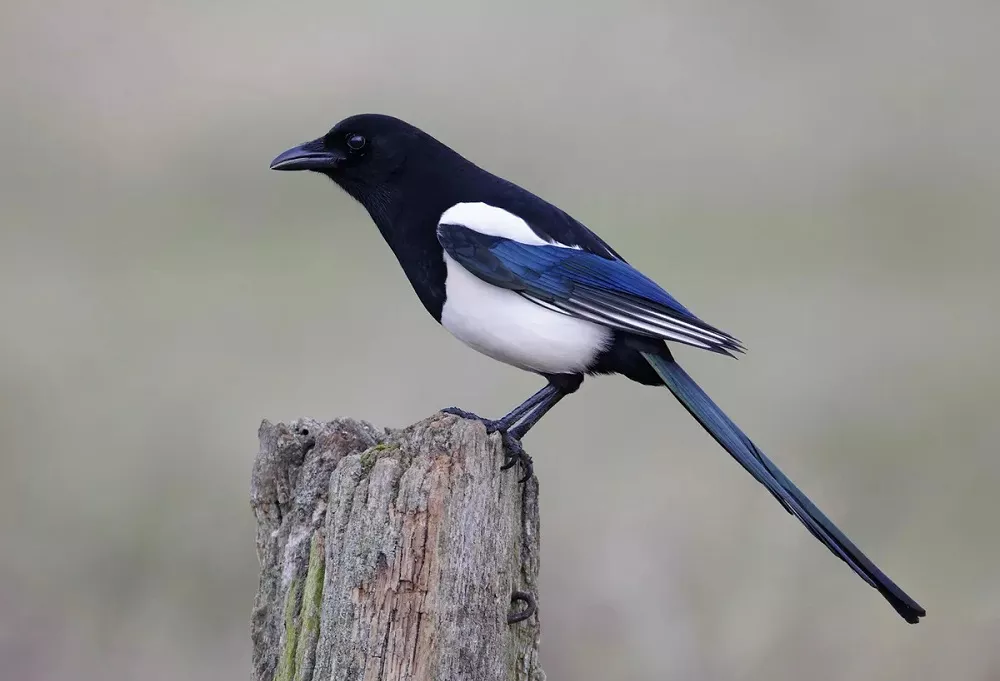The Eurasian magpie or common magpie (Pica pica) is a resident breeding bird throughout the northern part of the Eurasian continent. It is one of several birds in the crow family (corvids) designated magpies, and belongs to the Holarctic radiation of “monochrome” magpies.
The Eurasian magpie is one of the most intelligent birds, and it is believed to be one of the most intelligent of all non-human animals.
What does eurasian magpie look like?
The Eurasian magpie male adult bird: the head, neck, back and tail are covered with black feathers, the back of the head and the back of the neck are slightly stained with purple, and the back is slightly stained with blue-green; the shoulder feathers are pure white; the waist is gray and white mixed. The wings are black, the primary flight feathers have large white spots on the inside, the outer feathers and feather tips are black with blue-green luster; the secondary flight feathers are black with dark blue luster. Tail feathers are black with a dark green sheen, with purplish red and dark blue-green bands at the end. The chin, throat and chest are black, and the throat feathers sometimes have white shaft lines; the upper abdomen and flanks are pure white; the lower abdomen and leg coverings are black; the axillary feathers and wing coverts are light white.
Female adult bird: The body color is basically similar to that of the male bird, but the luster is not as prominent as that of the male bird. The black lower body is sometimes black or dark brown, and the white part is sometimes stained with gray. Juvenile bird: similar to the female bird, but the black part of the body is brown or dark brown; the white part is dirty white.
Iris dark brown; mouth, tarsus and toes are black.
Eurasian magpie habitat
The Eurasian magpie is a bird with strong adaptability. It lives in mountains and plains. It can be seen in wilderness, farmland, suburbs, cities, parks and gardens. But a general rule is that the more human activities there are, the more the population of The Eurasian magpie tends to be, and it is difficult to see this species in the inaccessible dense forest. The Eurasian magpies often form large groups and move in pairs, foraging in wilderness farmland during the day, and perching on the top of tall trees at night. The Eurasian magpies are one of the most popular birds. They like to build their nests on the big trees next to the houses and move around the settlements.
Eurasian magpie living habit
The Eurasian magpies usually move in small flocks of 3-5 magpies except in pairs during the breeding period, and often form large flocks of dozens of magpies in autumn and winter. It often goes to farmland and other open areas to look for food during the day, and flies to the nearby tall trees to rest in the evening. Sometimes it is also seen in mixed groups with Corvus and Western jackdaw. Vigilant in nature, one bird is always in charge of guarding when foraging. Even when foraging in pairs, they usually take turns to wait and forage. When the male bird looks for food on the ground, the female bird stands on the watch, and when the female bird feeds, the male bird watches. If danger is found, the watch bird makes a scream and flies away with the foraging bird. The flying ability is strong and long-lasting. When flying, the whole body and tail are in a straight line, the tail is slightly opened, and the two wings are beating slowly. The male and female birds often keep a certain distance, and they move forward by jumping when they are on the ground. The chirp is monotonous and loud, and it often chirps while flying. When in groups, the call is very noisy.
What does Eurasian magpie eat?
The feeding habits are mixed, and the food composition changes with the seasons and the environment. In summer, it mainly feeds on animal foods such as insects, and in other seasons, it mainly feeds on plant fruits and seeds.
Common food types include locusts, grasshoppers, scarabs, weevils, beetles, katydids, cutworms, pine caterpillars, stinkbugs, ants, flies, snakes and other Lepidoptera, Coleoptera, Orthoptera, Hymenoptera and other insects and The larvae also eat chicks and eggs. Plant food is mainly the fruits and seeds of plants such as trees and shrubs, and also eats crops such as corn, sorghum, soybeans, peas, and wheat.
Distribution area of Eurasian magpie
The Eurasian magpies have a wide distribution, covering almost all continents of the world except Antarctica, Africa, South America and Oceania.


 Facebook
Facebook  Instagram
Instagram  Youtube
Youtube 